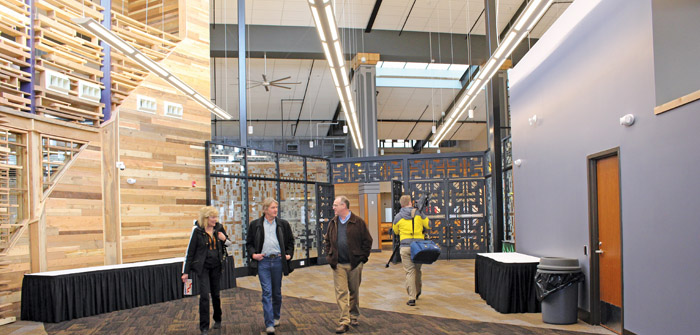(The Bert Mooney Airport Terminal in Butte, Montana incorporated architecturally exposed structural steel throughout the project | Photo Courtesy of Morrison-Maierle)
There’s no doubt about it: architecturally exposed structural steel (AESS) is a popular design choice not only because it can improve aesthetics but also add significant value to a building. Until a few years ago, the specifications were vague and too much was left up to design teams’ interpretation.
In 2016, the American Institute of Steel Construction (AISC) introduced a revised approach to the design and specification of AESS. In my opinion, previously the code did not clearly define the terms of AESS, leading to subjective opinions, incorrect interpretation and disagreements amongst team members in the field. The intent of the updated version is to provide clearly defined best practices, leading to the same level of expectations between the designers, fabricators and erectors.
The 2016 AISC implements a new, clearer approach to specifying AESS, organized using five categories. Each of the five categories (1, 2, 3, 4 and C) provides architects with a method of articulating AESS in their projects with a clear understanding of the final product.
The five categories defined in Section 10 of AISC are:
- AESS 1: Basic Elements — Minimum treatment beyond standard fabrication
- AESS 2: Feature Elements not in close view (greater than 20 feet)
- AESS 3: Feature Elements in close view (closer than 20 feet)
- AESS 4: Showcase Elements — Special surface and edge treatments
- AESS C: Custom Elements
Selecting the Correct Category
Several factors will influence the AESS Category that is right for your project. Primarily, it is important to understand the context surrounding the steel member/system before choosing the correct category. Some of the more common elements that can impact the category selection might include:
- Member visibility
- Viewing distance
- Location
- Lighting
- Coatings
- Building style
- Adjacent structures
Keep in mind too, that project costs are likely to increase as you move from AESS 1 to AESS C. Most likely, cost will be a big driver in the selection of the AESS Category. The best approach is to get the Category selected early in the project, maybe even shoot a little high in case Value Engineering (VE) plays a role in reducing the initial selection.
Getting the Timing Right
We all realize architecturally exposed steel can add significant value to a building. By selecting the appropriate AESS Category, design teams can help solidify this value. It is important to coordinate with your structural engineer since fabricators, erectors and contractors will refer to the structural drawings for fabrication, erection, field revisions, etc.
Like many aspects of the design process, AESS decision making is much easier when we plan ahead. Involving the entire design team as early as possible in the process to make these types of decisions is the best approach for all.
Making the right choice when it comes to exposed structural steel is something that takes time and research. We would be happy to answer any questions you might have as you plan and design your next project.
Nate J. Menuez, PE., LEED AP is a senior structural engineer in Morrison-Maierle’s Bozeman office. He is experienced in overall project management, design, construction management and special inspection high-end residential, educational campuses, commercial buildings, water/wastewater facilities, water holding structures and bridges. Nate has over 30 years of experience in the construction industry. He enjoys all things about the Montana lifestyle with his wife, Tracy, his son, Joey, his daughter, Mae and a truck full of English Setters.





